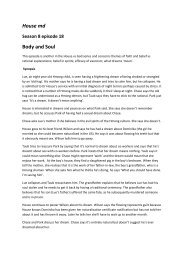Professor Stephen Pattison's Gifford Lectures on
Professor Stephen Pattison's Gifford Lectures on
Professor Stephen Pattison's Gifford Lectures on
You also want an ePaper? Increase the reach of your titles
YUMPU automatically turns print PDFs into web optimized ePapers that Google loves.
In the sec<strong>on</strong>d lecture, <str<strong>on</strong>g>Professor</str<strong>on</strong>g> Pattis<strong>on</strong> c<strong>on</strong>tinues his critique of dominant<br />
Western ways of seeing and thinking about sight. He will trace the rise of<br />
distancing objective sight; against this, he will advance a more intimate<br />
noti<strong>on</strong> of sight, ‘haptic’, or touching, visi<strong>on</strong>. Haptic sight figures the<br />
possibility that people can enter into rich, pers<strong>on</strong>like relati<strong>on</strong>s with at least<br />
some visible artefacts both within and bey<strong>on</strong>d the realm of art. <str<strong>on</strong>g>Professor</str<strong>on</strong>g><br />
Pattis<strong>on</strong> will suggest that sight is a capacity for relati<strong>on</strong>ship that is part of a<br />
total perceptual encounter with the world, so that perceivers and things<br />
that are seen are bound in a mutually affecting relati<strong>on</strong>ship. <str<strong>on</strong>g>Professor</str<strong>on</strong>g><br />
Pattis<strong>on</strong> will start with the example of former <str<strong>on</strong>g>Gifford</str<strong>on</strong>g> lecturer and<br />
theologian, Paul Tillich, who was physically shaken by an encounter with a<br />
visual artefact.<br />
Lecture 3 Sticky objects<br />
Turning from the attitudes of viewers, <str<strong>on</strong>g>Professor</str<strong>on</strong>g> Pattis<strong>on</strong> will use this<br />
lecture to selectively explore some of the factors that allow people to get<br />
pers<strong>on</strong>ally and deeply engaged with visual artefacts, as Tillich did with<br />
Botticelli’s ‘Mad<strong>on</strong>na with Singing Angels’. What are the elements that bind<br />
viewers to particular objects so that they become visually engaging? What<br />
is it that gives some objects a sense of real presence, so that people<br />
experience the resp<strong>on</strong>ses and reacti<strong>on</strong>s that they might have with another<br />
human being; and even have a sense that the object is invested with some<br />
kind of ability to enter into a mutual gaze?<br />
Lecture 4: Getting pers<strong>on</strong>al<br />
Having raised the issue of pers<strong>on</strong>like relati<strong>on</strong>ships with visual artefacts,<br />
this lecture enquires into whether, and how, artefacts might sensibly be<br />
regarded as pers<strong>on</strong>like. <str<strong>on</strong>g>Professor</str<strong>on</strong>g> Pattis<strong>on</strong> starts by looking at some<br />
examples of pers<strong>on</strong>like relati<strong>on</strong>s with artefacts in c<strong>on</strong>temporary life. He<br />
will then argue that artefacts are often so full of intenti<strong>on</strong> and emoti<strong>on</strong> that<br />
it is not surprising that people can encounter them as pers<strong>on</strong>like. Artefacts<br />
index their creators and acquire a kind of sec<strong>on</strong>dary social agency that<br />
shapes, enables and inhibits human actors materially and symbolically.<br />
<str<strong>on</strong>g>Professor</str<strong>on</strong>g> Pattis<strong>on</strong> will touch <strong>on</strong> the nature of pers<strong>on</strong>hood, suggesting that<br />
this may be inappropriately extended bey<strong>on</strong>d living members of humanity.














